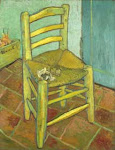
If there is one motif indelibly associated with van Gogh more than any other artist, it's the sunflower. He recognized it himself as "his" flower, and his paintings of sunflowers were among his own favorites in his oeuvre. He made eleven sunflower paintings between August 1887 and February 1889, four while he was living in Paris, seven while in Arles. The precise chronology (and in one case, the authenticity) of the Arles sunflower paintings remains debated, but here is one version of recent thinking:
*Vase With Three Sunflowers, private collection, late August 1888
*Vase With Four Sunflowers, lost in World War II, late August 1888
*Vase With Fourteen Sunflowers, Neue Pinakothek, Munich, late August 1888
*Vase With Sixteen Sunflowers, National Gallery, London (shown), late August 1888
*Vase With Sixteen Sunflowers, Seiji Togo Memorial Sompo Japan Museum of Art, Tokyo, early December 1888 (This version, a copy of the London canvas, is famous for selling at a then-record price at a 1987 auction. Its authenticity has been debated, but recent research on the canvas material suggests it is authentic and was painted during Paul Gauguin's stay in Arles.)
*Vase With Fourteen Sunflowers, Philadelphia Museum of Art, late January 1889 (A copy of the Munich canvas. Recent research suggests it was given by Theo van Gogh to Paul Gauguin as part of a picture exchange sometime in spring 1889. Gauguin greatly admired the London and Munich sunflower canvases--Vincent had hung them in Gauguin's bedroom in the yellow house--and wanted the originals. Vincent adamantly refused, but seems to have made the Philly version as a copy for Gauguin to have if it did not sell elsewhere.)
*Vase With Sixteen Sunflowers, Van Gogh Museum, Amsterdam, late January 1889 (another copy of the London canvas)
The four sunflower canvases done in August 1888 were intended to be part of a series of twelve to decorate Vincent's new house, to create an artistic atmosphere, as he said, like stained glass windows. They were painted at a time of cheerful, idealistic optimism for Vincent -- a point I've made before, that Vincent was not the perpetually gloomy, even violent, person that popular myth imagines him to be. Late summer/early autumn 1888 was a good time: he was excited about having a house of his own, he had big ideas about artists coming to stay and creating a 'studio of the south' (unfortunately, the first artist he invited--Paul Gauguin--did *not* turn out well and ended up being the only one). You can read his enthusiasm in his letters.
Another point is essential about the London and Munich canvases in particular, because it's not something most people realize when looking at the paintings ... they're fictions. Ever tried putting sunflowers in a vase? My sister and I made a trip to a local sunflower field in August 2006 while my novel manuscript was in its earliest draft -- an inspiration trip. The field was planted by a strawberry farmer wanting to have something pretty during the fallow period. A local newspaper wrote about it, and lots of folks stopped there to admire the flowers. We saw a couple of artists painting the day we went. I cut three sunflowers to take home (I wouldn't have, except the farmer was planning to raze the field the next week anyway, to plant the berries). Put them in a vase, then ... plunk! The vase tipped over. Sunflowers have very heavy heads. You can't have the stems too long and have a vase stay upright. That was three flowers -- fourteen or sixteen would be impossible! Sunflowers also wilt very quickly. Vincent complains about that in his letters to Theo and says he had to work fast. The London and Munich canvases are manipulations of nature: Vincent used real flowers as his inspiration, yes, but he did not sit in front of a vase of fourteen and sixteen sunflowers and paint them just like we see them. Nothing new in that -- 17th-century Dutch painters specialized in floral fictions, spectacular bouquets of flowers that bloom all seasons of the year and in that age, would be impossible to have all at the same time. It was standard procedure for Vincent anyway, to begin from nature and then make it his own. "I find it all ready in nature," he wrote Theo in a letter, "only it must be disentangled."
I thought about that when working on my manuscript, because it relates to what I see as the goals of historical fiction. Especially when writing about real people, it's important to have the facts straight and be as faithful as possible to history as we know it. But then you have those 'windows,' those places where we don't know the facts and where it is possible to invent and imagine -- put more flowers in the vase than historical sources show us. Present a beautiful fiction that looks pretty darn convincing and inspires emotion and depth of feeling from the viewer/reader. Van Gogh was a master of that, and it's a lesson for us all.
































